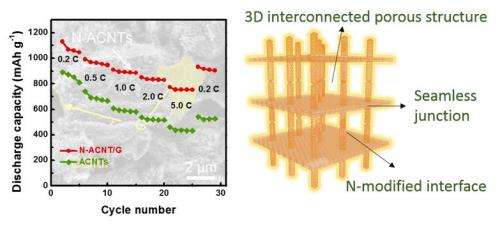Aligned carbon nanotube / graphene sandwiches

By in situ nitrogen doping and structural hybridization of carbon nanotubes (CNTs) and graphene via a two-step chemical vapor deposition (CVD), scientists have fabricated nitrogen-doped aligned carbon nanotube/graphene (N-ACNT/G) sandwiches with three-dimensional (3D) electron transfer pathways, interconnected ion diffusion channels, and enhanced interfacial affinity and activity. The as-fabricated N-ACNT/G sandwiches, described in the journal Advanced Materials on Sep 17 2014, demonstrated high-rate performances in lithium-sulfur (Li-S) batteries.
CNTs and graphene, the most highlighted sp2-bonded carbon nanomaterials over the past decades, have attracted enormous attention in the area of energy storage, heterogeneous catalysis, healthcare, environmental protection, as well as nanocomposites, which are highly dependent not only on their superior intrinsic physical properties, such as mechanical strength, electrical and thermal conductivity, but also on their tunable chemical characters, such as functional groups, doping, and surface modification. However, the heteroatom-containing nanocarbon tends to aggregate due to strong van der Waals interactions and large surface area explosion, thereby constantly limiting the demonstration of their intrinsic physical properties and performances in as-fabricated materials and practical devices.
The combination of CNTs and graphene into 3D hybrid composites can usually mitigate the self-aggregation and re-stacking of nanocarbon materials and also amplify physical properties at macroscale. Up to now, several strategies have been explored to fabricate such CNTs/graphene hybrids, including post-organization methods and in situ growth, while integration of high-quality CNTs and graphene without barrier layers is still difficult.
A team from Tsinghua University (China), led by Prof. Qiang Zhang and Fei Wei have now successfully fabricated sandwich-like N-ACNT/G hybrids via a two-step catalytic growth on bifunctional natural materials. Aligned CNTs were firstly intercalated into the interlayer spaces of the layered catalyst embedded with metal nanoparticles (NPs) through a low-temperature (L-T) CVD, and graphene was deposited sequentially onto the surface of lamellar flakes at the bottom of aligned CNTs through a high-temperature (H-T) CVD. NH3 was simultaneously introduced during the CVD growth for the incorporation of nitrogen atoms into the carbon framework. After catalyst removal, alternative aligned CNTs and graphene were vertically connected to each other in long-range periodicity, thereby forming a sandwich-like structure.
"The key issue for the fabrication of the novel N-ACNT/G architecture is that the high-quality aligned CNTs and graphene were grown on the NPs and lamellar flakes at L- and H-T CVD, respectively and conjointly." first-author Cheng Tang explained to Phys.Org, ''Thereby, the seamless connection of high-quality aligned CNTs and graphene provided 3D electron transfer pathways and interconnected ion diffusion channels. Also, the nitrogen doping induced moderate chemical modulation to the carbon framework, whereby enhanced the interfacial affinity and electrochemical activity."
One of the most promising candidates for next-generation power sources, Li-S battery is with very high theoretical energy density of 2600 Wh kg-1, natural abundance of element sulfur, and environment friendly as well. "We try to enhance the cyclic and rate performances of Li-S batteries for practical application with the N-ACNT/G hybrids as cathode materials." said Prof. Wei. A high initial reversible capacity of 1152 mAh g-1 can be available at 1.0 C, maintaining ca. 880 mAh g-1 after 80 cycles, which was about 65 % higher than that of sole aligned CNTs. Even at a high current density of 5.0 C, a reversible capacity of ca. 770 mAh g-1 can be achieved.
"The remarkable cycling capacity and rate capability can be attributed to the novel structural and chemical characteristics of the N-ACNT/G sandwiches", Prof. Zhang elaborated, "The seamless junction of CVD-grown aligned CNTs and graphene provides rapid electron transfer and mechanical robustness. The 3D interconnected mesoporous space improves the penetration and diffusion of electrolytes. Additionally, the nitrogen-modified interfaces give rise to enhanced interfacial affinity for efficient confinement and utilization of sulfur and polysulfides."
"It is highly expected that the N-ACNT/G sandwiches hold various potential applications in the area of nanocomposite, energy storage, environmental protection, electronic device, as well as healthcare, because of their robust hierarchical structure, 3D electron transfer pathways and ion diffusion channels, and enhanced interfacial affinity and activity as well." Prof. Zhang said, "Because such design and fabrication strategy is generally applicable, we foresee a new branch of material chemistry evolving in the area of advanced hierarchical nanostructures through the 3D topological nanosystems and interfacial modification."
More information: Tang C, Zhang Q, Zhao MQ, Huang JQ, Cheng XB, Tian GL, Peng HJ, Wei F. "Nitrogen-Doped Aligned Carbon Nanotube/Graphene Sandwiches: Facile Catalytic Growth on Bifunctional Natural Catalysts and Their Applications as Scaffolds for High-Rate Lithium-Sulfur Batteries." Advanced Materials 2014, 26(35), 6100-6105. DOI: 10.1002/adma.201401243
Journal information: Advanced Materials , Carbon
Provided by Tsinghua University

















